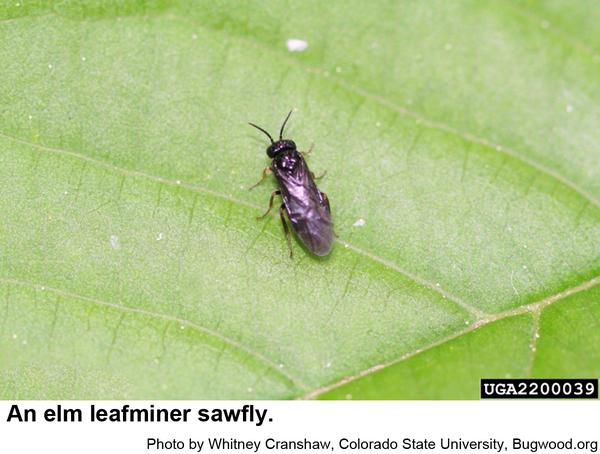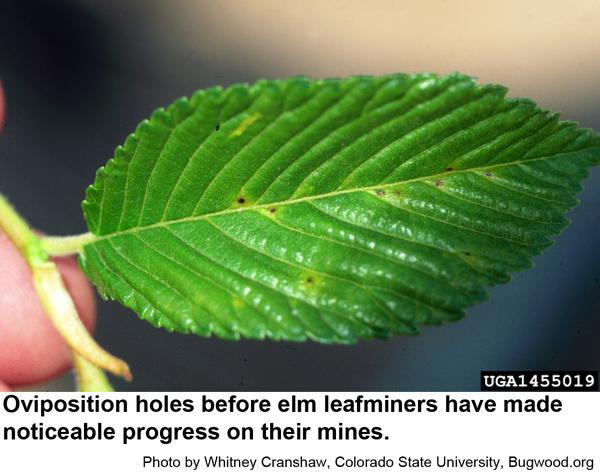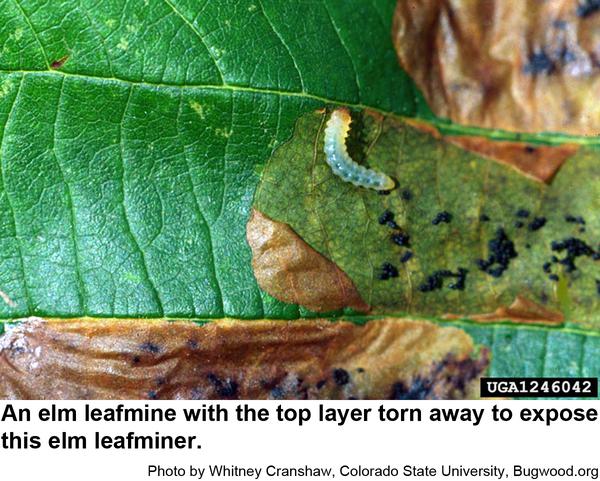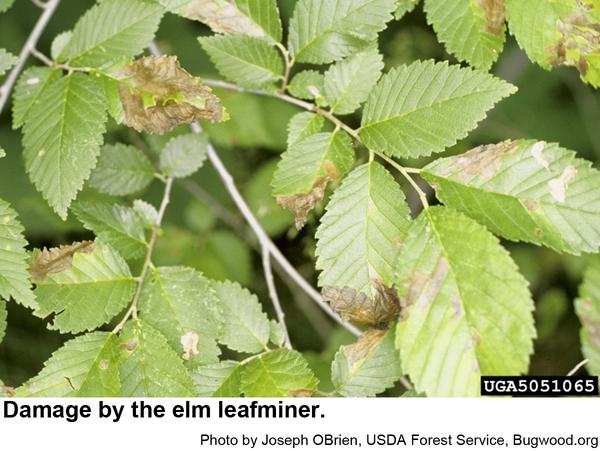Description and Biology
Female elm leafminer sawflies, Kaliofenusa ulmi or Fenusa ulmi, are tiny, dark, fly-like insects that emerge just as new growth begins on most elms (but after American elm). Apparently male elm leafminers are rare or don't occur at all. These sawflies tend to emerge during the middle of the day and immediately begin to insert up to 25 eggs per leaf near the central veins or they scatter them across the leaf. Tiny white caterpillars with pale brown heads hatch within 10 days. These leafminers resemble slug caterpillars but mine inside leaves rather than skeletonizing leaves from the outside. They feed between the upper and lower surfaces of the leaf causing blotch mines. If several larvae mine one leaf, the mines often coalesce leaving an entire leaf hollowed out. These leaves usually wither, die, and fall to the ground. If a leaf has only been partially mined, holes are left in the leaf as the miners emerge. After feeding, molting five times, and maturing, the 1⁄4 inch long leafminers emerge from the leaf, drop down, and dig into duff and topsoil to spin tough, brown, paper-like cocoons in which they spend the rest of the summer, fall, and winter as prepupae. They pupate in early spring. We have one generation per year at the most (some prepupae may remain in the cocoon for an additional year or even longer!)
Host Plants
The sawfly attacks American elm, Camperdown elm, English elm, Scotch elm, and Siberian elm. Leaves can be so heavily mined that the trees defoliate. However, because this is a spring pest and our growing season is so long, most trees flush out new growth and look fine by the end of summer. Some elms hold onto partially mined leaves─an aesthetic problem. Elm leafminers may attack the same trees year after year.
Residential Recommendations
Look for adults on the foliage in full sunlight to see them better. Small, new mines are also a good indicator that it's not too late to apply a systemic insecticide spray. If a tree is small enough, handpicking and destroying the mined leaves can be an effective means of control. However, damage is often discovered after the leafminers have dropped to the soil so applying an insecticide after mid July is not helpful. Next spring, imidacloprid or some other systemic insecticide can be sprayed at bud break to try to interrupt their cycle of existence (Soil applications of systemic insecticides work better if they are applied during late winter). American elm may have some resistance, but its susceptibility to Dutch elm disease limits its usefulness in the landscape.
Other Resources
- Elm Leafminer. Anonymous. 2015 (modified). Trees, insects and diseases of Canada's forests, Natural Resources Canada.
- Elm Leafminer. Rosetta, R.? No Date 2016?. Pacific Northwest Pest Management Handbook, Insect.
- Elm (Ulmus)-Elm leafminer, Fenusa ulmi. Hollingsworth, C.S. (Ed.). 2020. Pacific Northwest Insect Management Handbook, Oregon State University.
- Insects that Feed on Trees and Shrubs. Johnson, W.T. and H.H. Lyon. 1991. 2nd. Ed. Cornell University Press. 560 pp.
- The Biology and Seasonal Life History of the Elm Leaf Miner, Fenusa ulmi (Sundevall), in the Pacific Northwest (Hymenoptera: Tenthredinidae).Scannell, C.M. 2000. Master's Thesis, University of Washington.
- NC State Extension Plant Pathology Publications
- NC State Horticultural Science Publications
- North Carolina Agricultural Chemicals Manual
For assistance with a specific problem, contact your local N.C. Cooperative Extension center.
This factsheet has not been peer reviewed.
Publication date: Aug. 3, 2020
Reviewed/Revised: May 8, 2025
Recommendations for the use of agricultural chemicals are included in this publication as a convenience to the reader. The use of brand names and any mention or listing of commercial products or services in this publication does not imply endorsement by NC State University or N.C. A&T State University nor discrimination against similar products or services not mentioned. Individuals who use agricultural chemicals are responsible for ensuring that the intended use complies with current regulations and conforms to the product label. Be sure to obtain current information about usage regulations and examine a current product label before applying any chemical. For assistance, contact your local N.C. Cooperative Extension county center.
N.C. Cooperative Extension prohibits discrimination and harassment regardless of age, color, disability, family and marital status, gender identity, national origin, political beliefs, race, religion, sex (including pregnancy), sexual orientation and veteran status.






